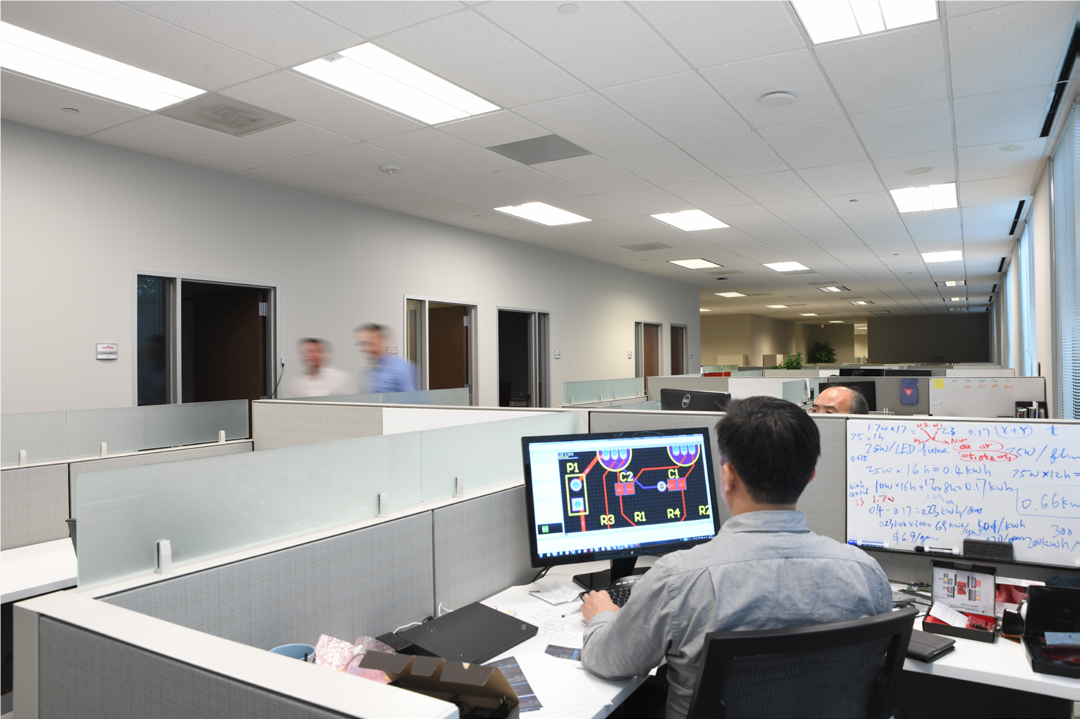Bluetooth® Mesh is the first low-energy communication standard to provide a reliable, fast, and scalable wireless lighting control system. Silvair has successfully tested the new technology at its headquarters in Krakow and implemented it for a customer in Dallas. At Silvair’s headquarters, the conventional lighting system was converted to a wireless lighting control network throughout the office.
Advanced lighting control concepts improve office lighting efficiency and reduce energy costs. Presence detection via sensors and the use of daylight are among the most effective methods. In addition to wireless lighting control, Silvair implemented these two strategies in its offices and installed sensors that measure room occupancy and ambient light.
Data Traffic Based on Information Instead of Devices

Bluetooth® Mesh networks enable many-to-many communication between many devices and are ideal for creating IoT solutions that require several thousand devices to communicate reliably and securely with each other. It brings the proven, worldwide interoperability and the mature, trustworthy overall system of Bluetooth technology to the creation of industry-compatible device networks.
The communication principles introduced in this way correspond to the approach of Information-Centric Networking (ICN). This concept was developed to cope with the increasing data traffic by name-based addressing and forwarding concepts as core principles. Instead of sender and recipient, information based on names takes center stage and makes data independent of location, storage, or application. Bluetooth Mesh lighting networks are based on the publish-subscribe principle. Here, addresses are assigned information, not specific devices. The luminaires subscribe to messages from certain addresses so that they can react to relevant messages. Other devices publish to these addresses and distribute lighting control commands simultaneously to all affected recipients.
Simultaneous multicasting spreads messages with a single transmission to many nodes and is an essential prerequisite for lighting applications. In commercial environments, dozens or more network nodes must simultaneously respond to lighting control commands with full synchronization and minimal latency. Bluetooth Mesh networking is the only solution where multiple multicast messages can be sent simultaneously over the network. This makes Bluetooth® Mesh lighting systems robust.
Reliability and Performance Through Simultaneous Multicasting

Through simultaneous multicasting, wireless installations achieve the trouble-free performance and scalability of wired systems. Even difficult radio conditions can be compensated, as practical examples show.
A significantly reduced data volume sets Bluetooth Mesh networking apart from other wireless systems. With centralized radio-based networks, the data always runs via a central control device. This not only makes it a single point of failure, but also creates bottlenecks. This is because the sensors send information to the central control hardware, which in turn sends commands to each of the associated devices. This multiplies the volume of data traffic and is a real problem, especially for lighting applications where an immediate response is required.
Bluetooth® Mesh networking shifts the control functions to the individual devices. This reduces the volume of data traffic by half and enables a decentralized architecture without bottlenecks or single points of failure. Bluetooth Mesh networks do not require any central control devices, as a software controller is built into each luminaire. They also do not require gateways, as Bluetooth is already integrated in every personal computing device. This allows a smartphone to connect directly to any node when commissioning or configuration tasks are performed.
Compared to other mesh systems, Bluetooth Mesh networks use smaller data packets. They are very compact because the protocol is designed to transport large quantities of small packets as quickly as possible. More compact data packets generate fewer packet collisions, which is crucial for reliable and scalable communication.
Practical Experience with Silvair and Its Customers
Silvair, a pioneer in intelligent lighting solutions based on Bluetooth® technology, has expanded the LED system installed at its Polish headquarters into a sensor-controlled adaptive network based on this technology. Due to frequent radio interference, such an office does not appear to be particularly suitable for radio communication. In addition to all smartphones and laptops, many test devices ensure extremely high data traffic. But even under these circumstances, wireless lighting control based on Bluetooth works reliably and synchronously throughout the office.
The existing luminaires with 230V LED drivers from BOKE were retained. A mesh bridge was installed in each luminaire and a presence and ambient light sensor from Osram was installed directly next to it in the ceiling panels. The mesh bridge is a Silvair reference design. It is a device controller that converts Bluetooth Mesh commands to a standard 0-10V output, transforming an existing lighting system into a Bluetooth Mesh system.

The sensor-based lighting control automatically and smoothly adjusts the brightness of the luminaires to the occupancy and availability of daylight. In each room, there is a wireless switch with which the scenario can be controlled as required. All luminaires in the building can also be switched off immediately via a main switch.
In addition to modern control functions, Bluetooth Mesh networks enable further services based on the lighting infrastructure. Silvair Monitoring is a package of software tools that provides valuable insights into room usage, for example. Together with the Japanese technology company Murata, the company has implemented a wireless control system in the Billingsley Company office building in Dallas, Texas. The rooms were divided into different zones for daylight use, and detailed data was collected on the presence of people and the energy consumption of individual rooms. In rooms with windows, ambient light sensors communicate with the mesh-based luminaires so that daylight is used and a constant brightness level is ensured throughout the day. All rooms are also equipped with presence detectors. This helps to reduce costs and optimise the working environment for employees. The occupancy data can be displayed in heating cards. The company thus not only saves energy but also optimises space utilisation.
Silvair’s lighting control technology has recently been adopted in more practical implementations in a variety of environments. In addition to the projects mentioned above, the company’s solutions were implemented in a school in Jaworzno, Poland, and in a 25,000 square metre warehouse of luminaire manufacturer McWong in Sacramento. Silvair is convinced that the Bluetooth Mesh standard — due to its open nature and enormous technological potential — will democratise lighting control. The technical and economic requirements for the implementation of efficient sensor-controlled control strategies can be significantly reduced with it. Whether this will be the case has not yet been determined, but these initial implementations do indeed look very promising.
To learn more about Bluetooth® Mesh, download Bluetooth Mesh Networking: An Introduction for Developers.